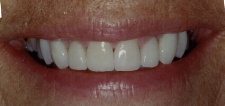The First Question—Whom Do You Trust to Do Your Porcelain Veneers?
If you are looking for basic information about porcelain veneers, the first question you need answered is who is qualified to do them? Most dental procedures are done to fix mechanical problems in the mouth. There is a cavity—it needs to be filled. A tooth is broken—it needs to be rebuilt and reinforced so it won’t break again. Porcelain veneers, however, are done to create a beautiful smile. It is an artistic procedure. The most common misconception we see in the general public is that their family dentist can do a smile makeover. You’re asking for trouble when you do this. To me, it seems like asking the painter who did such a great job on painting your living room to now create a landscape painting to hang in that living room. Just having the skills to work with the materials doesn’t make one an artist. I have received hundreds of e-mails from patients who paid thousands of dollars for a smile makeover from their family dentist and are now asking me how to fix their drab smile.
If you are contemplating having porcelain veneers done, I urge you to read through this website and learn the difference between a general dentist who understands the mechanics of working with cosmetic dentistry materials and an artistic cosmetic dentist who can create a beautiful smile.
Here is an example of a porcelain veneers case that I placed:

Before

After

After Close Up
What Are Porcelain Veneers?
They are thin wafers of porcelain that are bonded on top of your natural teeth. They can be anywhere from 0.3 millimeter to 0.5 millimeter thick, or thicker if necessary to create the proper look. To give you an idea how thick that is, 0.5 millimeter is about the thickness of your fingernail. Usually, the tooth has to be prepared at least a little in order to produce an ideal result. Sometimes, with the ultra-thin veneers, they can be placed without any tooth preparation.
Porcelain is the ideal material for a smile makeover. The surface is extremely hard—even harder than tooth enamel. If the glaze is kept intact, it is also more stain-resistant than enamel. And the color, surface texture, and translucency can be manipulated to perfectly mimic natural tooth structure. Even as a highly experienced cosmetic dentist, I can’t tell from the appearance of a tooth from the front whether or not it is a natural tooth or porcelain.
The Fear of Tooth Preparation
Tooth decay and gum disease are both caused by micro-organisms. These micro-organisms are looking for tiny crevices in the teeth and discrepancies.

Key: P=porcelain veneer,
C=bonding resin (cement),
E=enamel,
D=dentin
(photomicrograph courtesy of sciencedirect.com)
Some patients are worried about having the tooth shaved a little before placing the porcelain veneer. As mentioned above, it is possible, with some ultra-thin porcelains, to avoid any tooth preparation. But there is a misconception I would like to clear up that this is somehow healthier for the tooth. That isn’t true, and let me explain why. To make a smooth margin between the porcelain and the tooth, it is best to have a little of the tooth structure shaved away so that when the porcelain is placed, the resulting margin is smooth.
To illustrate that, see the microscopic view on the left, which shows a porcelain veneer placed on a slightly prepared tooth. If the porcelain is placed directly over unprepared enamel, it leaves a ridge, an unevenness, that attracts plaque bacteria and stain. The healthiest final result is to have this margin as smooth as possible. And that is best achieved with a slight tooth preparation similar to what is shown here.
Further information:
- Read about the porcelain veneers procedure–how they are made and placed.
- Read about what you should do to take care of porcelain veneers if you have them.
- Read about the art of smile design. How does the shape of your teeth affect how others perceive you?
This content was written by Dr. David Hall. Click here to ask Dr. Hall a question.
